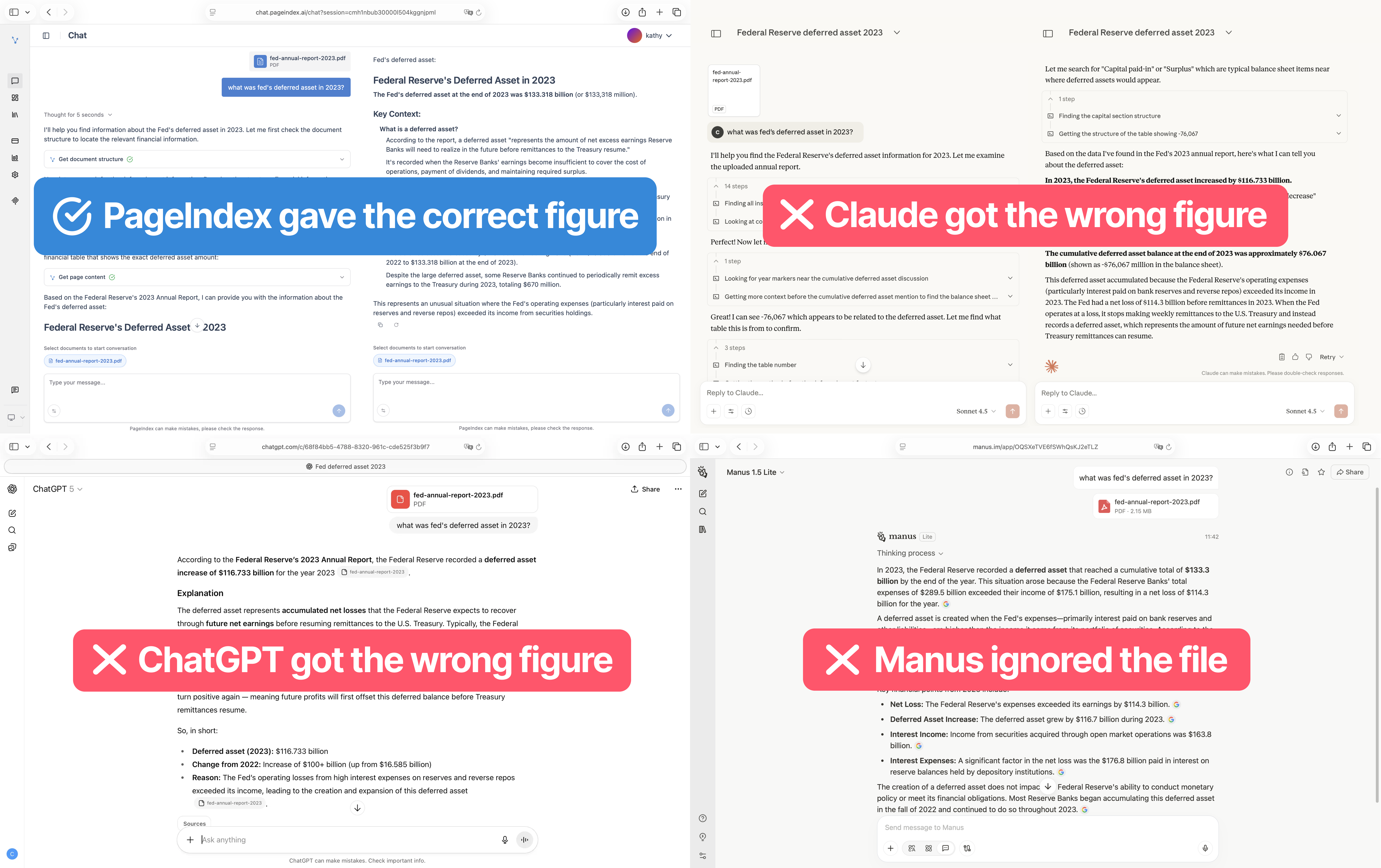
We're excited to introduce PageIndex Chat, the world's first human-like long-document AI analyst designed for professional long documents. With PageIndex Chat, you can upload entire books, research papers, or hundred-page reports and have conversations without context limits — all in your browser, with no setup required.
Built to Analyze Documents Like a Human Expert
PageIndex Chat is a reasoning-based, human-like AI document analyst based on our PageIndex. Whenever you ask a question about a lengthy document, instead of searching for information by matching keywords or scanning text superficially (like most other AI tools do), it reasons through the document like an experienced human expert to find precise, contextual answers.
Compared to other AI tools, PageIndex Chat offers numerous advantages:
1. Page-Level References – Every answer comes with exact page numbers and citations, so you can trace insights directly back to their source. This transparency builds trust and makes verification effortless.
2. Deep Reasoning – PageIndex doesn't just retrieve information; it interprets and connects ideas. It distinguishes between totals and changes, reads context across sections, and synthesizes findings into meaningful insights.
3. Human-in-the-Loop Collaboration – Designed to complement human expertise, PageIndex enables a collaborative workflow. You can guide its reasoning, refine its focus, or validate results — combining AI precision with professional judgment.
4. Multi-Document Comparison – Real analysis rarely stops at one source. PageIndex can analyze and compare multiple documents at once, revealing trends, inconsistencies, and relationships across reports and datasets.
To illustrate how these capabilities come together in practice, let's look at a challenging real-world example that highlights PageIndex's powerful reasoning ability and how it can assist in your daily work.
Example: Reasoning-Based Question Answering on Long Documents
To demonstrate the reasoning process, we use a 222-page document — Federal Reserve Annual Report 2023 — as an example. The task is to find the “deferred asset” value for 2023.
This question is particularly challenging because the main body of the report mentions only a change in the deferred asset (“increased deferred asset”) rather than providing its total value. In fact, the complete figure for the total deferred asset appears solely in the report’s appendix. This type of question is especially difficult for current AI systems, as discussed in this blog post.
This is how PageIndex solves this problem:
- PageIndex begins by reading the Table of Contents of the report to locate the section most likely to contain the answer. It identifies the relevant section as “5 Payment System and Reserve Bank Oversight → Oversight of Federal Reserve Banks,” which is located on pages 75–82.
- On page 79, PageIndex finds the following text: “Deferred asset (increase) decrease: -$116,733 million for 2023.” It correctly interprets this figure as the change (increase/decrease) in the deferred asset, not the total amount. Therefore, PageIndex determines this is not the final answer and continues searching.
- On page 77, it encounters this note: “Table 5.3 summarizes the income, expenses, and distributions of the Reserve Banks for 2023 and 2022. Appendix G of this report, ‘Statistical Tables,’ provides more detailed information…” From this, PageIndex infers that the detailed data (including the total value it seeks) is likely located in Appendix G.
- It refers back to the Table of Contents to find the page number of Appendix G, navigates there, and extracts the relevant data from the appendix to obtain the correct total value.
This human-like reasoning process accurately identifies the precise information needed to answer the user’s question, provides a clear and transparent reasoning path, and includes page references to deliver verifiable answers without hallucinations.
We also tested the same question on ChatGPT 5, Claude Sonnet 4.5 and Manus; all failed to give the correct answer.

Try It Now
PageIndex Chat is available now in Beta at: chat.pageindex.ai. Upload your long document today and experience document intelligence with no context limits.